2002 CHEVROLET AVEO child seat
[x] Cancel search: child seatPage 1493 of 5127

Securing a Child Restraint Designed
for the LATCH System
1. Find the LATCH anchorages for the seating
position you want to use, where the bottom of the
seatback meets the back of the seat cushion.
SeeLower Anchorages and Top Tethers for
Children (LATCH System) on page 1-41.
2. Put the child restraint on the seat.
3. Attach and tighten the LATCH attachments on the
child restraint to the LATCH anchorages in the
vehicle. The child restraint instructions will show
you how.
4. If the child restraint is forward-facing, attach and
tighten the top tether to the top tether anchorage.
The child restraint instructions will show you
how. Also seeTop Strap on page 1-38.
5. Push and pull the child restraint in different
directions to be sure it is secure.
To remove the child restraint, simply unhook the top
tether from the top tether anchorage and then
disconnect the LATCH attachments from the LATCH
anchorages.
Securing a Child Restraint in a
Rear Seat Position
If your child restraint is equipped with the LATCH
system, seeLower Anchorages and Top Tethers for
Children (LATCH System) on page 1-41. SeeTop Strap
on page 1-38if the child restraint has one.
If your child restraint does not have the LATCH system,
you will be using the lap-shoulder belt to secure the
child restraint. Be sure to follow the instructions
that came with the child restraint. Secure the child in
the child restraint when and as the instructions say.
1. Put the child restraint on the seat.
2. Pick up the latch plate, and run the lap and shoulder
portions of the vehicle’s safety belt through or
around the restraint. The child restraint instructions
will show you how.
1-44
Page 1495 of 5127
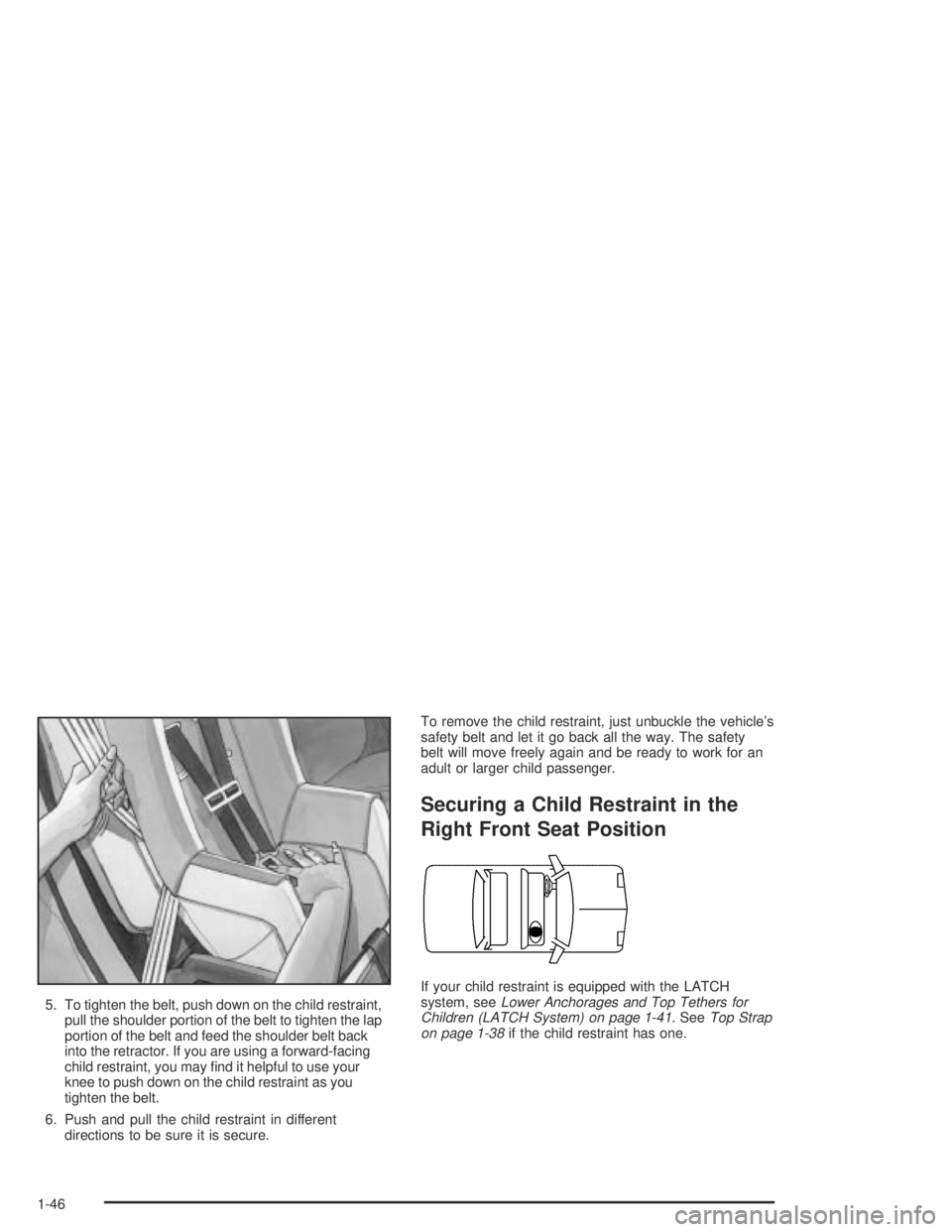
5. To tighten the belt, push down on the child restraint,
pull the shoulder portion of the belt to tighten the lap
portion of the belt and feed the shoulder belt back
into the retractor. If you are using a forward-facing
child restraint, you may find it helpful to use your
knee to push down on the child restraint as you
tighten the belt.
6. Push and pull the child restraint in different
directions to be sure it is secure.To remove the child restraint, just unbuckle the vehicle’s
safety belt and let it go back all the way. The safety
belt will move freely again and be ready to work for an
adult or larger child passenger.
Securing a Child Restraint in the
Right Front Seat Position
If your child restraint is equipped with the LATCH
system, seeLower Anchorages and Top Tethers for
Children (LATCH System) on page 1-41. SeeTop Strap
on page 1-38if the child restraint has one.
1-46
Page 1496 of 5127
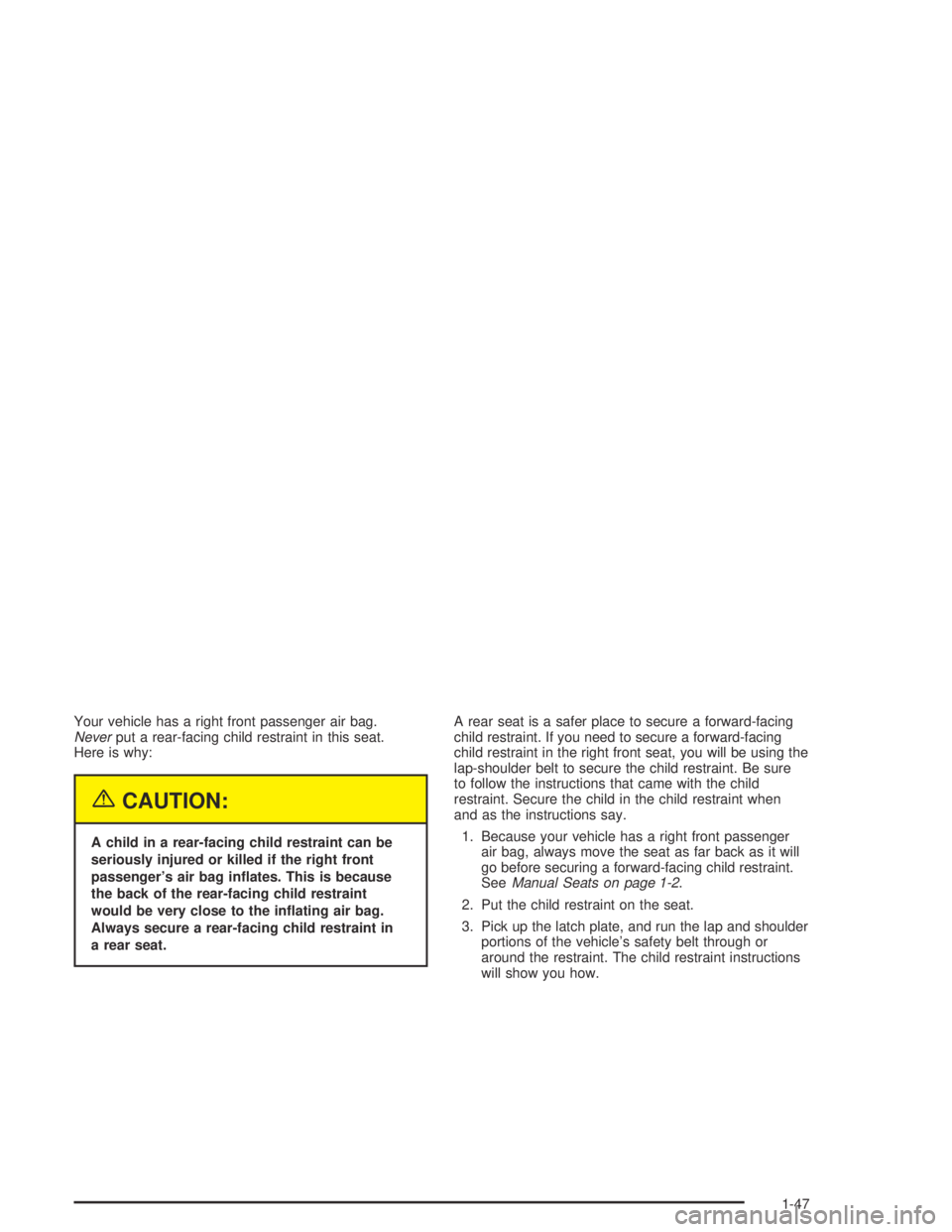
Your vehicle has a right front passenger air bag.
Neverput a rear-facing child restraint in this seat.
Here is why:
{CAUTION:
A child in a rear-facing child restraint can be
seriously injured or killed if the right front
passenger’s air bag in�ates. This is because
the back of the rear-facing child restraint
would be very close to the in�ating air bag.
Always secure a rear-facing child restraint in
a rear seat.A rear seat is a safer place to secure a forward-facing
child restraint. If you need to secure a forward-facing
child restraint in the right front seat, you will be using the
lap-shoulder belt to secure the child restraint. Be sure
to follow the instructions that came with the child
restraint. Secure the child in the child restraint when
and as the instructions say.
1. Because your vehicle has a right front passenger
air bag, always move the seat as far back as it will
go before securing a forward-facing child restraint.
SeeManual Seats on page 1-2.
2. Put the child restraint on the seat.
3. Pick up the latch plate, and run the lap and shoulder
portions of the vehicle’s safety belt through or
around the restraint. The child restraint instructions
will show you how.
1-47
Page 1628 of 5127
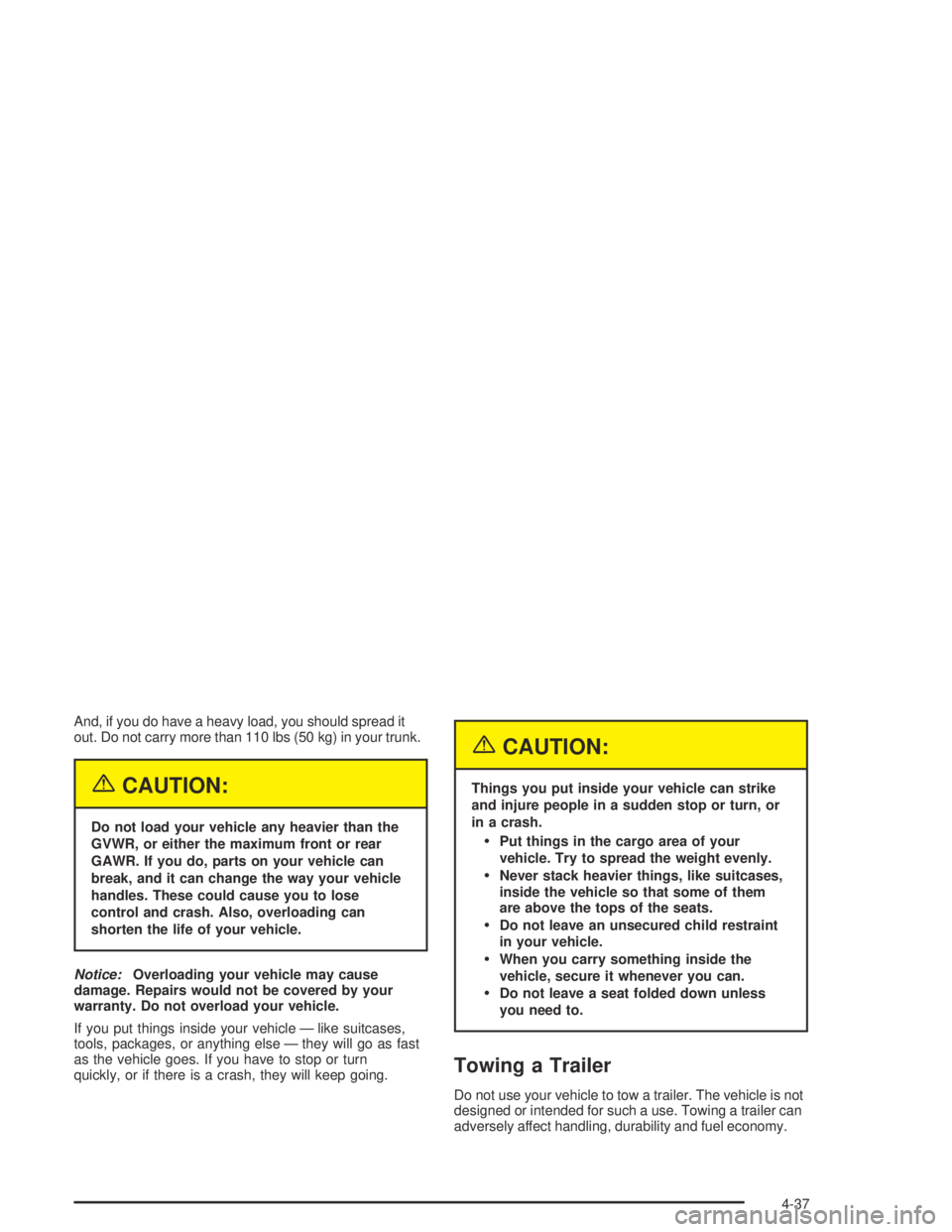
And, if you do have a heavy load, you should spread it
out. Do not carry more than 110 lbs (50 kg) in your trunk.
{CAUTION:
Do not load your vehicle any heavier than the
GVWR, or either the maximum front or rear
GAWR. If you do, parts on your vehicle can
break, and it can change the way your vehicle
handles. These could cause you to lose
control and crash. Also, overloading can
shorten the life of your vehicle.
Notice:Overloading your vehicle may cause
damage. Repairs would not be covered by your
warranty. Do not overload your vehicle.
If you put things inside your vehicle — like suitcases,
tools, packages, or anything else — they will go as fast
as the vehicle goes. If you have to stop or turn
quickly, or if there is a crash, they will keep going.
{CAUTION:
Things you put inside your vehicle can strike
and injure people in a sudden stop or turn, or
in a crash.
Put things in the cargo area of your
vehicle. Try to spread the weight evenly.
Never stack heavier things, like suitcases,
inside the vehicle so that some of them
are above the tops of the seats.
Do not leave an unsecured child restraint
in your vehicle.
When you carry something inside the
vehicle, secure it whenever you can.
Do not leave a seat folded down unless
you need to.
Towing a Trailer
Do not use your vehicle to tow a trailer. The vehicle is not
designed or intended for such a use. Towing a trailer can
adversely affect handling, durability and fuel economy.
4-37
Page 1637 of 5127
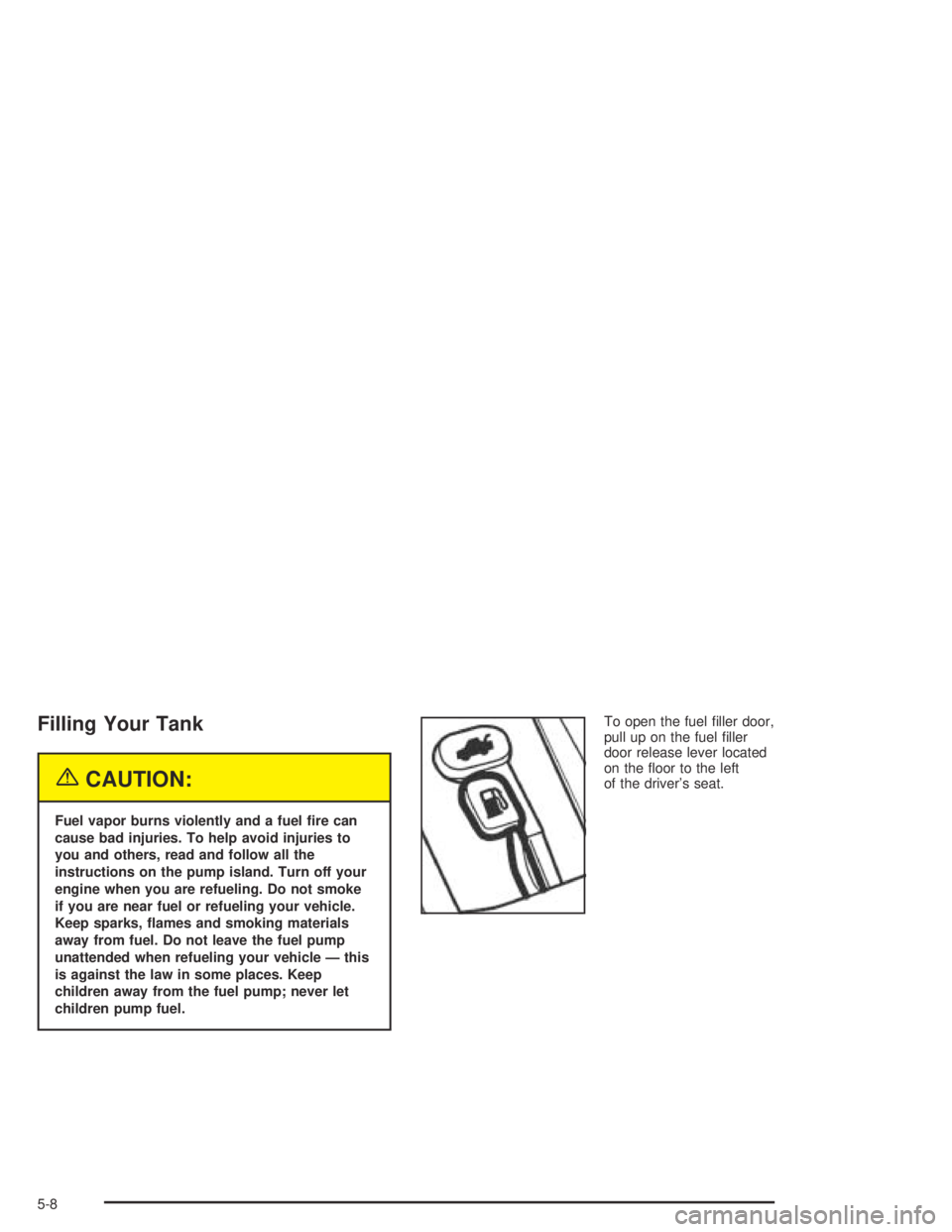
Filling Your Tank
{CAUTION:
Fuel vapor burns violently and a fuel �re can
cause bad injuries. To help avoid injuries to
you and others, read and follow all the
instructions on the pump island. Turn off your
engine when you are refueling. Do not smoke
if you are near fuel or refueling your vehicle.
Keep sparks, �ames and smoking materials
away from fuel. Do not leave the fuel pump
unattended when refueling your vehicle — this
is against the law in some places. Keep
children away from the fuel pump; never let
children pump fuel.To open the fuel filler door,
pull up on the fuel filler
door release lever located
on the floor to the left
of the driver’s seat.
5-8
Page 1766 of 5127

Child Restraints
Child Restraint Systems...............................1-34
Infants and Young Children...........................1-30
Lower Anchorages and Top Tethers for
Children (LATCH System)..........................1-41
Older Children.............................................1-28
Securing a Child Restraint Designed for
the LATCH System...................................1-44
Securing a Child Restraint in a Rear Seat
Position..................................................1-44
Securing a Child Restraint in the Right Front
Seat Position...........................................1-46
Top Strap...................................................1-38
Top Strap Anchor Location............................1-40
Where to Put the Restraint...........................1-37
Cigarette Lighter.............................................3-12
Cleaning
Inside of Your Vehicle..................................5-76
Outside of Your Vehicle................................5-79
Underbody Maintenance...............................5-82
Weatherstrips..............................................5-79
Cleaning Aluminum Wheels..............................5-81
Cleaning Exterior Lamps/Lenses.......................5-80
Cleaning Fabric/Carpet....................................5-76
Cleaning Glass Surfaces..................................5-78
Cleaning Interior Plastic Components.................5-78
Cleaning Leather............................................5-78Cleaning the Top of the Instrument Panel...........5-78
Cleaning Tires................................................5-81
Cleaning Vinyl................................................5-78
Cleaning Windshield and Wiper Blades..............5-80
Climate Control System...................................3-12
Air Filter, Passenger Compartment.................3-16
Outlet Adjustment........................................3-15
Clock............................................................3-25
Clutch, Hydraulic.............................................5-22
Compact Spare Tire........................................5-75
Control of a Vehicle.......................................... 4-6
Coolant
Engine Temperature Gage............................3-21
Heater, Engine............................................2-21
Surge Tank Pressure Cap.............................5-25
Cooling System..............................................5-28
Cupholder(s)..................................................2-36
Current and Past Model Order Forms................7-12
Customer Assistance Information
Courtesy Transportation.................................. 7-7
Customer Assistance for Text
Telephone (TTY) Users............................... 7-4
Customer Assistance Offices........................... 7-4
Customer Satisfaction Procedure..................... 7-2
GM Mobility Program for Persons with
Disabilities................................................ 7-5
Reporting Safety Defects to General Motors.......7-11
3
Page 1772 of 5127
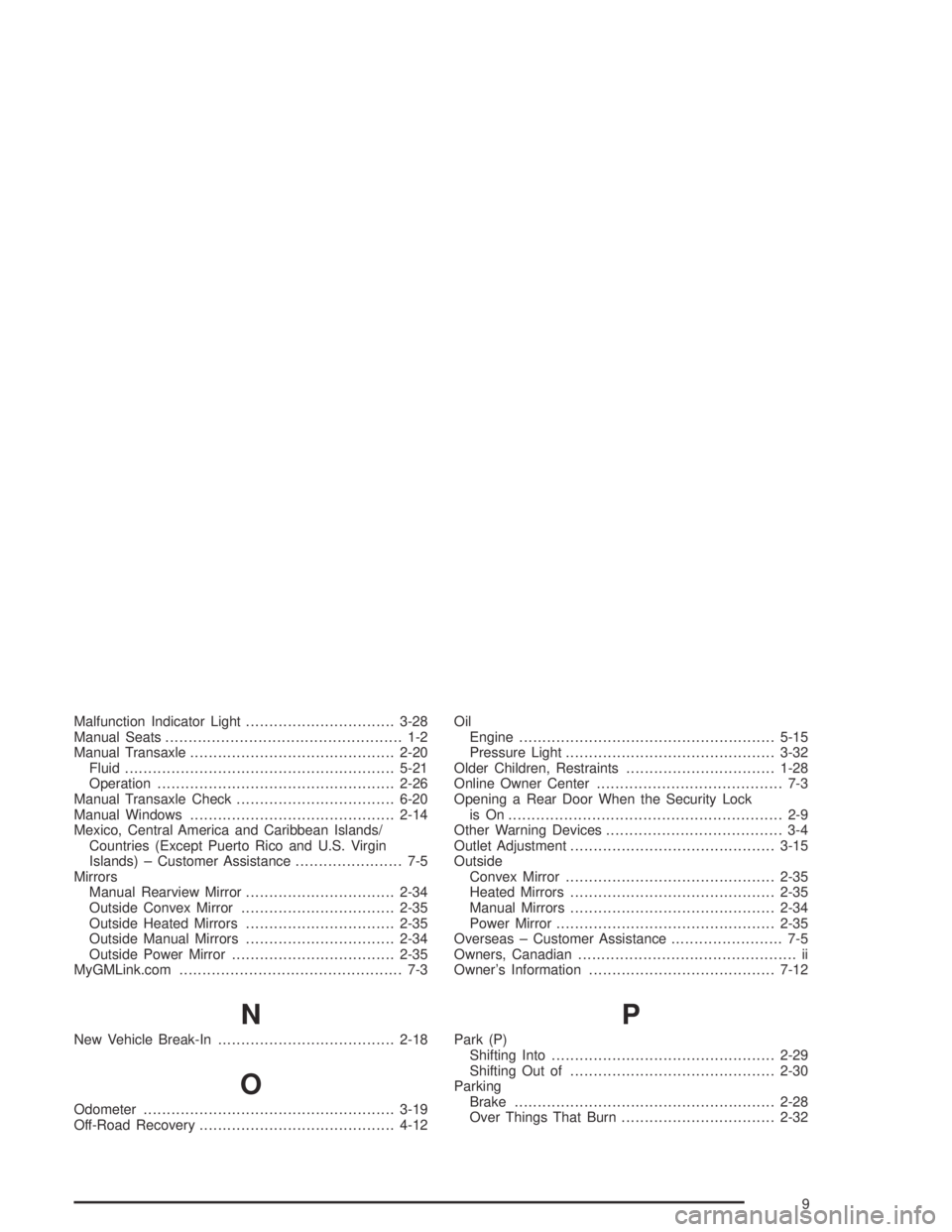
Malfunction Indicator Light................................3-28
Manual Seats................................................... 1-2
Manual Transaxle............................................2-20
Fluid..........................................................5-21
Operation...................................................2-26
Manual Transaxle Check..................................6-20
Manual Windows............................................2-14
Mexico, Central America and Caribbean Islands/
Countries (Except Puerto Rico and U.S. Virgin
Islands) – Customer Assistance....................... 7-5
Mirrors
Manual Rearview Mirror................................2-34
Outside Convex Mirror.................................2-35
Outside Heated Mirrors................................2-35
Outside Manual Mirrors................................2-34
Outside Power Mirror...................................2-35
MyGMLink.com................................................ 7-3
N
New Vehicle Break-In......................................2-18
O
Odometer......................................................3-19
Off-Road Recovery..........................................4-12Oil
Engine.......................................................5-15
Pressure Light.............................................3-32
Older Children, Restraints................................1-28
Online Owner Center........................................ 7-3
Opening a Rear Door When the Security Lock
is On ........................................................... 2-9
Other Warning Devices...................................... 3-4
Outlet Adjustment............................................3-15
Outside
Convex Mirror.............................................2-35
Heated Mirrors............................................2-35
Manual Mirrors............................................2-34
Power Mirror...............................................2-35
Overseas – Customer Assistance........................ 7-5
Owners, Canadian............................................... ii
Owner’s Information........................................7-12
P
Park (P)
Shifting Into................................................2-29
Shifting Out of............................................2-30
Parking
Brake........................................................2-28
Over Things That Burn.................................2-32
9
Page 1774 of 5127
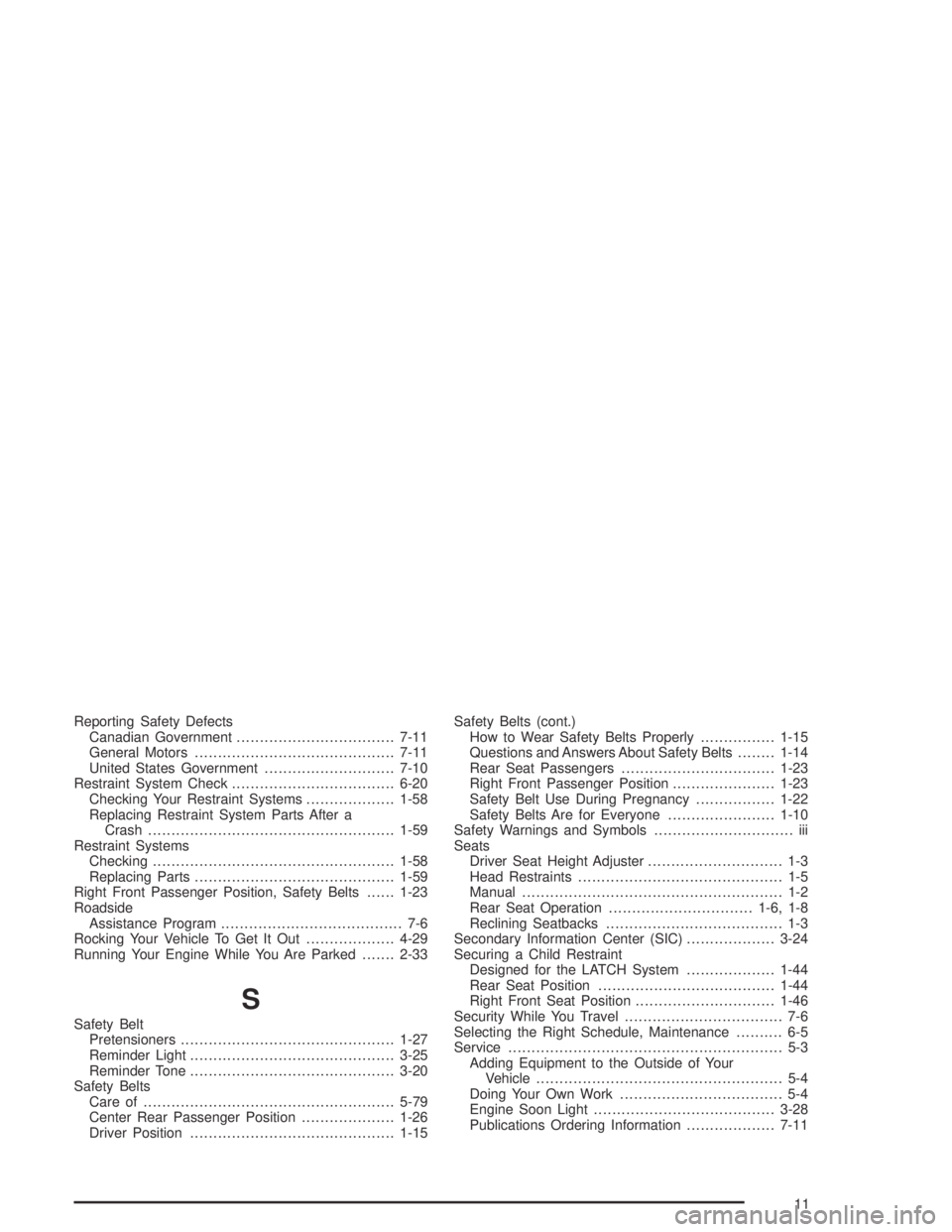
Reporting Safety Defects
Canadian Government..................................7-11
General Motors...........................................7-11
United States Government............................7-10
Restraint System Check...................................6-20
Checking Your Restraint Systems...................1-58
Replacing Restraint System Parts After a
Crash.....................................................1-59
Restraint Systems
Checking....................................................1-58
Replacing Parts...........................................1-59
Right Front Passenger Position, Safety Belts......1-23
Roadside
Assistance Program....................................... 7-6
Rocking Your Vehicle To Get It Out...................4-29
Running Your Engine While You Are Parked.......2-33
S
Safety Belt
Pretensioners..............................................1-27
Reminder Light............................................3-25
Reminder Tone............................................3-20
Safety Belts
Care of......................................................5-79
Center Rear Passenger Position....................1-26
Driver Position............................................1-15Safety Belts (cont.)
How to Wear Safety Belts Properly................1-15
Questions and Answers About Safety Belts........1-14
Rear Seat Passengers.................................1-23
Right Front Passenger Position......................1-23
Safety Belt Use During Pregnancy.................1-22
Safety Belts Are for Everyone.......................1-10
Safety Warnings and Symbols.............................. iii
Seats
Driver Seat Height Adjuster............................. 1-3
Head Restraints............................................ 1-5
Manual........................................................ 1-2
Rear Seat Operation...............................1-6, 1-8
Reclining Seatbacks...................................... 1-3
Secondary Information Center (SIC)...................3-24
Securing a Child Restraint
Designed for the LATCH System...................1-44
Rear Seat Position......................................1-44
Right Front Seat Position..............................1-46
Security While You Travel.................................. 7-6
Selecting the Right Schedule, Maintenance.......... 6-5
Service........................................................... 5-3
Adding Equipment to the Outside of Your
Vehicle..................................................... 5-4
Doing Your Own Work................................... 5-4
Engine Soon Light.......................................3-28
Publications Ordering Information...................7-11
11